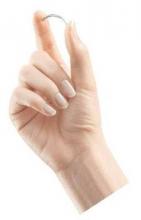On Sept. 24, the Food and Drug Administration’s Obstetrics and Gynecology Devices Panel will meet in Silver Spring, Md., to consider the future of the Essure permanent contraceptive device.
Essure consists of an inner stainless steel coil wrapped in polyethylene terephthalate fibers and encased in an outer nickel-titanium coil. It’s delivered hysteroscopically for partial placement into the fallopian tube.
Once in place, the fibers trigger scar formation to block the tube.
When approved in 2002, “it finally looked like we had the answer that we were looking for,” an effective, quick, and inexpensive sterilization procedure that could be done in-office without anesthesia, said Dr. James Presthus, an early adopter at Minnesota Gynecology & Surgery in Edina, Minn., and a former Essure adviser.
But through May 2015, the FDA has received 5,093 reports of sometimes-severe problems with Essure, including chronic pelvic pain, dysmenorrhea, constitutional symptoms, and a handful of deaths that may, or may not, be associated with the device.
The reports and the upcoming FDA meeting are being driven by women who say they have been hurt by Essure. They’ve organized online to share their stories; the Facebook page Essure Problems is probably their largest meeting space, with almost 20,000 members.
Patients on the page have been encouraging each other to report problems to the FDA, and some are involved in legal action against manufacturer Bayer HealthCare.
Complaints ignored
There’s anger behind those efforts, and part of it is due to how women say they have been treated by their physicians. Social media is full of stories from patients who say their concerns were dismissed by physicians who told them that Essure couldn’t be the cause of their problems, or that hysterectomy was the only way to get the coils out.
Both of those assertions are false, said Dr. Edio Zampaglione, vice president of Bayer’s Women’s Health Division and an ob.gyn.
According to company estimates, Essure causes chronic pain in about 4% of women, especially if it’s not placed correctly or migrates and punctures surrounding tissue. Constitutional symptoms – for example, rashes, joint pain, hair loss, and weight changes – could be related to the nickel in Essure’s outer coil, if patients are allergic.
“We do believe these women” and take their reports seriously, Dr. Zampaglione said.
Bayer is reaching out to them for more information, and beefing up the physician-training programs it inherited when it bought Essure’s original maker, Conceptus, in 2013, he said.
Current labeling recommends salpingotomy or salpingectomy as first-line options for removal, and after a request from the FDA, Bayer is updating Essure’s label to give more information on how to use those procedures to remove the device.
Doctors who recommend hysterectomy first are probably just staying in their comfort zone, Dr, Zampaglione said.
It’s difficult to pinpoint the exact adverse event rate for Essure, but Bayer asserts – and physicians with no connections to the company said – that complications are rare.
The cases reported to the FDA represent less than 1% of the 750,000 women Bayer estimates have received the device, most of them in the U.S. Even so, adverse event reporting to the agency is notoriously low for drugs and devices, 10% or less by most estimates.
“I’ve implanted hundreds of these over the years. A lot of those patients come back to me for annual examinations, and they are not reporting problems,” Dr. Presthus said, but “after almost 13 years, we are finding out that Essure is not perfect; nothing is.”
It’s also difficult to separate out coincidence from true problems with the device. Outside of uterine anomalies, nickel allergy seems to be the only definitive indicator that patients will have problems with Essure. Until more is known, timing is the key to figuring out if Essure needs to come out, Dr. Presthus said.
“If somebody has it put in and then has all kinds of pelvic pain, it’s pretty easy to make the connection that it could be the device. Certainly, when patients have allergic reactions that started after they had it implanted,” Essure needs to be addressed, he said.
Removal without hysterectomy
His first step in such cases is to remove the device to see if it helps. Over the past year, Dr. Presthus has done two or more cases a week laparoscopically and said he hasn’t run into problems. The cases take about a half-hour each, and 80% or more of women report symptom relief.





